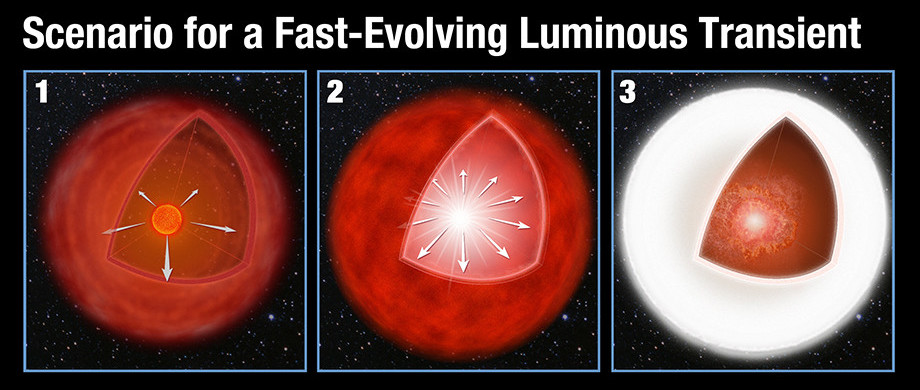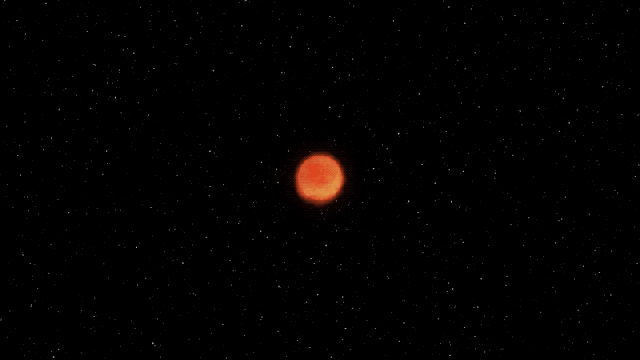Supernovae produce some of the most powerful explosions in the cosmos, expelling a doomed star’s contents at velocities reaching 10 per cent the speed of light. It usually takes a few weeks or months for a supernova to fade into nothingness, but astronomers have now documented a record-setting case in which a star was extinguished in just a few days.
Artist’s depiction of a FELT. GIF: NASA/JPL
They’re called Fast-Evolving Luminous Transients (FELTs), an exotic type of supernova discovered only a few years ago. As the name implies, these supernovae develop quickly, they’re very bright, and then they disappear. Unlike more “conventional” supernovae, such as Type Ia supernovae, the duration of these explosions can be measured in days rather than weeks or months. These celestial events are rare, and only a handful of FELTs have ever been documented.
The perplexing thing about FELTs, however, isn’t so much that they’re short-lived – it’s that they’re also very bright. Scientists have subsequently theorised that they’re the glowing remnant of a gamma-ray burst (a massive explosion produced by a collapsing star that gives birth to a black hole), a supernova fuelled by a magnetar (a neutron star with a powerful magnetic field), or a failed Type Ia supernova (in which a white dwarf star sucks up material from a nearby star, eventually causing it to explode). New research published this week in Nature Astronomy suggests it’s none of the above.
Using data collected by the Kepler space telescope, an international team of astronomers led by Brad Tucker from Australian National University has documented the death throes of a star located 1.3 billion light-years away. Known as KSN 2015K, this unprecedented FELT reached its maximum brightness in just 2.2 days, which is 10 times faster than standard supernovae. After 6.8 days, it dimmed to half its peak luminosity, and by the 25th day it was gone. Its rapid rise and fall is unlike anything ever seen before, and the most dramatic example yet of a FELT.

Artist’s impression of a FELT. Image: NASA
In terms of what’s going on, the researchers say the star had a kind of near-death experience prior to going supernova. About a year before it went supernova, and as a grim portent of things to come, the star experienced a mini-eruption, burping a dense shell of gas and dust into the cosmos. A year later, the star eventually exploded, hurtling material outwards at extreme velocities. Eventually, this wave of energy and debris caught up to the outer shell. The resulting collision created a glowing light bulb of cosmic proportions – one that resulted in a rapid brightening, and quick fade out; most of the energy expelled by the supernova turned to light when it smashed into the shell of gas and dust.
“We’ve discovered yet another way that stars die and distribute material back into space,” said Tucker in a statement.
These observations were made possible by NASA’s Kepler space telescope, which chronicled the event across 30-minute intervals. Kepler is normally used to detect exoplanets, but in this case it was in the service of the Kepler Extra-Galactic Survey, which includes scientists from Australia, the United States and Chile. Researchers leveraged the spacecraft’s ability to sample sudden changes in a star’s luminosity at a rapid rate, and it’s the first time astronomers were able to test their assumptions and theories about FELTs to such a high degree of accuracy.
“The fact that Kepler completely captured the rapid evolution really constrains the exotic ways in which stars die,” said co-author David Khatami of the University of California at Berkeley in a statement. “The wealth of data allowed us to disentangle the physical properties of the phantom blast, such as how much material the star expelled at the end of its life and the hypersonic speed of the explosion.”
Looking ahead, the researchers would like to learn more about the stars that give birth to FELTs, and capture more of these rare supernovae in action.
